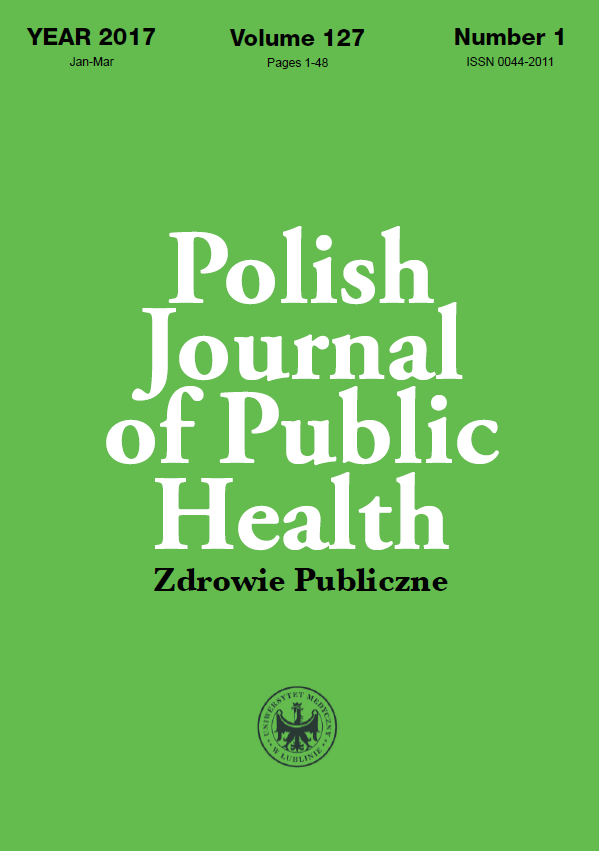The quality of life perception by gender and place of residence during assessment of thrombocytopenia impact on patients’ daily activities using TSIDAV vignette
DOI:
https://doi.org/10.1515/pjph-2017-0005Keywords:
quality of life, vignette, thrombocytopeniaAbstract
Introduction. The term “quality of life” has been present in the literature for a long time now. It was created in the middle of the last century in Western Europe and from the societal perspective the term initially defined the level of material life, gradually being expanded to other aspects of human life, like happiness, education, broadly defined individual freedom and health.
Aim. To analyze differences by gender and place of residence in perception of quality of life based on data from the assessment of thrombocytopenia impact on daily activities using TSIDAV vignette among Polish patients.
Material and methods. We assessed the impact of thrombocytopenia symptoms on patients’ daily activities using TSIDAV vignette. We wanted to understand the reason for different perception of symptoms and why visible symptoms are perceived as worse by women in comparison to men. We analyzed the groups by age and place of residence.
Results. Within 48 collected questionnaires, 31 were provided by women and 17 by men. As many as 29% of men declared the biggest impact on daily activities due to petechiae and easy bruising. The same symptoms were assessed as having significant impact on daily activities by 68% and 65% of women respectively. The results in relation to the two symptoms were similar in terms of impact: both men and women assessed it as high impact, however in general, a lower proportion of men identified this as an issue. As many as 53% of the pre-menopausal women declared the thrombocytopenia impact on daily activities as very high. Similar results were observed in the male group. Those before retirement age assessed disease symptoms as very high in comparison to the group of older patients. No significant differences in relation to place of residence were observed. During literature research we found that depending on patients’ gender, the perception of the impact of disease on patients quality of life may often differ.
Conclusions. We found out that the perception of disease symptoms impact on quality of life is different by women and men. That may be the result of different factors such as the influence of social roles determined for each sex. At the same time, the perception of the impact of thrombocytopenia symptoms on daily activity almost does not depend on age or place of residence of neither women nor men.
References
1. Telka E. Ocena jakości życia w wymiarze psychologicznym, zdrowotnym i społecznym. Nowa Med. 4/2013.
2. Cieślik A, Słopiecka A. Quality of life in the social sciences. Stud Med. 18/2010.
3. Drozd M, Szkultecka-Dębek M, Bem M, et al. Thrombocytopenia Symptoms and their Impact on Patients Daily Activities assessment Vignette (TSIDAV) – validation of the vignette. JHPOR. 2016;1. [http://www.jhpor.com/index/artykul/pokaz/thrombocytopenia_symptoms_and_their_impact_on_patients_daily_activities_assessment_vignette_tsidav__validation_of_the_vignette]
4. Szkultecka-Dębek M, Drozd M, Nowakowska M, et al. The assessment of the impact of thrombocytopenia symptoms on the patients’ daily activities with the use of TSIDAV vignette. JHPOR. 2016;1. [http://www.jhpor.com/index/artykul/pokaz/the_assessment_of_the_impact _of_thrombocytopenia_symptoms_on_the_patients_daily_activities_with_the_use_of_tsidav_vignette]
5. Kotlarska-Michalska A. Społeczne role kobiet. Edu Human. 2011;1(24).
6. Santé publique, qualité de vie et maladies chroniques, Direction Générale de la Santé: Actes du séminaire préparatoire au plan visant à améliorer la qualité de vie des personnes atteintes de maladies chroniques. Paris ; 2004.
7. Owisiński JW, Tarchalski T. Pomiar jakości życia. Uwagi na marginesie pewnego ranking. Współcz Probl Zarządz. 2008;1.
8. Pertyński T. Menopauzalny okres życia kobiety. Przew Lek. 2002;5(1/2):69-71. [http://www.termedia.pl/Czasopismo/Przewodnik_Lekarza-8/Streszczenie-701.]
9. Przekwitanie. Klinika Endokrynologii Ginekologicznej. Warszawski Uniwersytet Medyczny. [https://endogin.wum.edu.pl/sites/endogin.wum.edu.pl /files/okres_przekwitania_u_kobiet.pdf.]
10. Szkup-Jabłońska M, Tutaj E, Jurczak A, et al. Wpływ warunków socjodemograficznych na jakość życia kobiet w okresie pomenopauzalnym. Perinatol Neonatol Ginekol. 2012;5(1):34-38. [http://www.ptmp.com.pl/ png/png5z1_2012/PNG51-6-Szkup.pdf.]
11. Vázquez I, Valderrábano F, Fort I, et al. Differences in health-related quality of life between male and female hemodialysis patients. Nefrol. 2004;24(2):167-78.
12. Snyder CF, Mathias SD, Cella D, et al. Health-related quality of life of immune thrombocytopenic purpura patients: results from a web-based survey. Curr Med Res Opin. 2008;24(10):2767-76.
13. Böhm D, Stock Gissendanner S, Bangemann K, et al. Perceived relationships between severity of psoriasis symptoms, gender, stigmatization and quality of life. J Eur Acad Dermatol Venereol. 2013;27(2):220-6.
14. Paruzel-Czachura M. Poczucie jakości życia i poziomu wyczerpania witalnego u aktywnych zawodowo kobiet i mężczyzn. Studia Psychologica UKSW. 2013;13(1).
Downloads
Published
Issue
Section
License
Copyright (c) 2017 Polish Journal of Public Health

This work is licensed under a Creative Commons Attribution-NonCommercial-NoDerivatives 3.0 Unported License.


